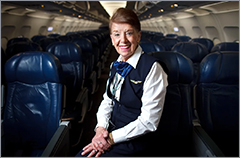Tech Tools for Aging in Place
KIPLINGER RETIREMENT REPORT OFFERS SOLUTIONS
 The May Kiplinger Retirement Report includes a report on technology tools that are designed to help older adults age in place. EverSafe was one of numerous tools referenced in the article. The piece recognized that the various needs of our ever-growing older population have outpaced available resources. But fueled by the COVID epidemic, technology solutions have evolved to address many of the challenges facing seniors. Some of these include: healthcare measures, home safety, caregiving solutions, and financial health. As noted in Kiplinger, “family members may live in different cities and states or even just have different schedules and demands and yet still want to keep track of and care for older members. Tech can facilitate coordinating appointments and connections.” And don’t make the mistake of assuming that older adults don’t use technology. According to Forbes, as of March 2024, 88% of people age 65 and older in the US have access to the internet.
The May Kiplinger Retirement Report includes a report on technology tools that are designed to help older adults age in place. EverSafe was one of numerous tools referenced in the article. The piece recognized that the various needs of our ever-growing older population have outpaced available resources. But fueled by the COVID epidemic, technology solutions have evolved to address many of the challenges facing seniors. Some of these include: healthcare measures, home safety, caregiving solutions, and financial health. As noted in Kiplinger, “family members may live in different cities and states or even just have different schedules and demands and yet still want to keep track of and care for older members. Tech can facilitate coordinating appointments and connections.” And don’t make the mistake of assuming that older adults don’t use technology. According to Forbes, as of March 2024, 88% of people age 65 and older in the US have access to the internet.
What Makes an Elder a Super-Ager?
RESEARCH ON BRAINS OF THE 80-PLUS HOLDS ANSWERS
Adults who are age 80 and older are at greater risk for memory decline than younger seniors. In the last several years, scientists have researched the brains of these older adults in an effort to learn whether cognition always declines with age. The researchers found that a small number of these seniors have the memory ability of adults who are 30 years younger. This cohort has been  dubbed “super-agers,” by gerontologists. Research published this month in the Journal of Neuroscience outlined interesting new findings with respect to the brains of these super-agers. In comparing cat scans of their brains to those with “normal” memory ability, the scientists found that the super-agers have more physical volume in the parts of their brain that are important for memory. The brains of super-agers also show less atrophy in its “white matter” than those of their peers. A separate study examined how biological factors and family history may be relevant when studying the super-ager. Dr. Emily Rogalski, from the Feinberg School of Medicine at Northwestern University, uses a more holistic analysis: “We all encounter stress and have the opportunity to react in different ways. One reaction can be to rise above and it seems like these SuperAgers are particularly good at really identifying the best in a situation and figuring out how to move on,” she noted. There is no real data on how many super-agers there are in the US, but they are “relatively rare,” according to Rogalski. She believes that far less than 10% of the people she sees end up meeting the criteria.
dubbed “super-agers,” by gerontologists. Research published this month in the Journal of Neuroscience outlined interesting new findings with respect to the brains of these super-agers. In comparing cat scans of their brains to those with “normal” memory ability, the scientists found that the super-agers have more physical volume in the parts of their brain that are important for memory. The brains of super-agers also show less atrophy in its “white matter” than those of their peers. A separate study examined how biological factors and family history may be relevant when studying the super-ager. Dr. Emily Rogalski, from the Feinberg School of Medicine at Northwestern University, uses a more holistic analysis: “We all encounter stress and have the opportunity to react in different ways. One reaction can be to rise above and it seems like these SuperAgers are particularly good at really identifying the best in a situation and figuring out how to move on,” she noted. There is no real data on how many super-agers there are in the US, but they are “relatively rare,” according to Rogalski. She believes that far less than 10% of the people she sees end up meeting the criteria.
OLDER AMERICANS MONTH
Every May, the Administration for Community Living (ACL) recognizes May as Older Americans Month, a time to “recognize the contributions of seniors, highlight aging trends, and reaffirm commitments to serving the older adults in our communities.” This year’s theme was entitled “Powered by Connection,” which focused on the critical importance that connections have on the well-being and health of older adults. As the US Center for Disease Control has recognized (CDC), seniors who are lonely or socially isolated are at greater risk for serious medical conditions. A number of national organizations that offer helpful resources are listed on their site. In that one in five adults experience a mental health condition in later life, including depression, tips on recognizing the signs are critical.
SCAM ALERT
POSTAL FRAUD IS ON THE RISE
There are individuals who avoid using technology for financial transactions because they worry about cyber fraud. These folks prefer traveling to “brick and mortar” financial institutions (banks with a physical presence in a building) and “snail mail” (conventional method of sending material via the US Postal Service). But technology offers a number of advantages over traditional banking, not the least of which is comprehensive monitoring for suspicious financial activity − which may include a  fraudulent change of address form, theft, or even account-takeover. Technology services can scan for anomalies in transactions at all hours of the day and night to assist customers in shutting down unauthorized activity – at its inception.
fraudulent change of address form, theft, or even account-takeover. Technology services can scan for anomalies in transactions at all hours of the day and night to assist customers in shutting down unauthorized activity – at its inception.
A recent case in New York State illustrates the challenges in identifying fraud within the traditional banking system. Tameka Babulal has been charged with stealing checks and credit cards mailed by victims and then using them for personal gain. The allegations include “depositing altered checks stolen from victims into personal finance accounts and also coordinating with co-conspirators to take victims’ personal identifying information,” according to law enforcement sources. This information was then used to open fraudulent accounts in the victims’ names. Officials added that police also found several forged social security cards and tax documents as well as “washed checks” during their search of the defendant’s home. Mail fraud is on the rise. FinCEN issued an alert last year, indicating that there were 680,000 cases of possible check fraud reported in 2022, up from 350,000 in 2021 − which itself was a 23% increase over reports in 2020.
RIP Bette Nash
REMEMBERING THE WORLD’S OLDEST STEWARDESS
Bette Nash, who held the Guinness World Record for the longest-serving flight attendant, passed away earlier this month at the age of 88, according to American Airlines and the Association of Professional Flight Attendants. With a career spanning nearly  seven decades, Nash saw many changes in the world of flight. When she was interviewed at age 80, she told CNN that when she started, planes were “places of luxury… a time when everyone wore their Sunday best and ate lobster on real china.” Nash knew she wanted to become a flight attendant when she was 16 years old. As she recalled, “I was sitting with my mother on a green leather couch at Washington [Reagan National Airport], and this crew came up from TWA…The pilot and the flight attendant walked across the hall and I thought ‘Oh my God,’ … that was for me.” According to one of her colleagues, Nash had a special needs son and chose short routes so that she could be home with him every night. Click to see a video of this amazing senior aviation icon, joking with her passengers: World’s Most Senior Flight Attendant Gives New Crew Advice …
seven decades, Nash saw many changes in the world of flight. When she was interviewed at age 80, she told CNN that when she started, planes were “places of luxury… a time when everyone wore their Sunday best and ate lobster on real china.” Nash knew she wanted to become a flight attendant when she was 16 years old. As she recalled, “I was sitting with my mother on a green leather couch at Washington [Reagan National Airport], and this crew came up from TWA…The pilot and the flight attendant walked across the hall and I thought ‘Oh my God,’ … that was for me.” According to one of her colleagues, Nash had a special needs son and chose short routes so that she could be home with him every night. Click to see a video of this amazing senior aviation icon, joking with her passengers: World’s Most Senior Flight Attendant Gives New Crew Advice …